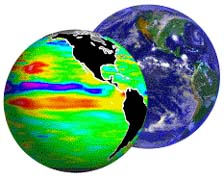| . |  |
. |
 Climate's Slow Cycle Of Oceanic Change
Climate's Slow Cycle Of Oceanic ChangeWashington - March 22, 2000 - Scientists at Scripps Institution of Oceanography at the University of California, San Diego, report evidence of pronounced changes in the earth's climate that can be tracked in cycles of ocean conditions over thousands of years. These cycles reveal that Earth is currently in a period in which a natural rise in global temperatures -- combined with warming from the greenhouse effect -- will push the planet through an era of rapid global warming. Charles Keeling and Timothy Whorf report in the March 21 online edition of the Proceedings of the National Academy of Sciences (PNAS) that strong oceanic tides are the engines behind this warming-cooling cycle that may help determine future climates. This report is the first comprehensive study of the effects of tidal mixing on climate change spanning millennia. The current phase in the cycle suggests that a natural warming trend began a hundred years ago, picked up in the 1970s, and should continue over the next five centuries. "We have discovered an 1,800-year tidal cycle that appears to match with recent climate change," said Charles Keeling, the study's first author. "If this is a correct mechanism for understanding climate change over millennia, then temperatures will rise both because of weaker tidal mixing and because of the greenhouse effect, which is on the increase as well." The researchers suggest that strong oceanic tides drive changes in climate due to their ability to increase vertical mixing in the ocean and thereby transport cold ocean water to the surface. The strong tides elicit cool conditions on the sea surface, which in turn lowers temperatures in air and over land, resulting in cooler climates around the planet, often accompanied by drought conditions. Weak tides lead to less cold water mixing and result in warmer periods on Earth. Keeling and Whorf's 1,800-year cycle, which arises because of gradual changes in the astronomical alignments of the sun, moon, and earth, was proposed as an explanation for nearly periodic millennial changes in temperature seen in ice and deep-sea sedimentary core records. Previously (1997), they have reported on the effects of shorter cycles of tidal forcing on global temperature at periods near 18, 90, and 180 years. A maximum in tidal cooling near 1974 might have produced more cooling, but perhaps was masked by a simultaneous greenhouse warming, according to Keeling, a professor of oceanography at Scripps. "If that is true, then it becomes pretty clear that if today's natural warming trend is combined with the greenhouse effect, then we'll soon see the effect of combined warming all over the world," said Keeling. In addition to climate change recognition, the research also represents a new mechanism for analyzing events in world history. The paper reports on the near coincidence of major tidal fluctuations with worldwide phenomena, including the Little Ice Age of 1400 A.D. to 1700 A.D., major dust layers in Minnesota lake sediments spaced about 1,800 years apart, a major drought in the Amazon Basin around 2200 B.C., and a 2000 B.C. drought that may have contributed to the collapse of Akkadia, a Mesopotamian civilization regarded as the world's first empire. The Vikings inhabited Greenland in temperate conditions in the tenth century near the end of a period of weak tidal activity, but perished or left Greenland when tides strengthened near the beginning of the Little Ice Age in the 13th century. "One of the principle benefits of the tidal hypothesis is that researchers can compare the timing of specific historical events with predicted times of warming or cooling to see whether they coincide or not," said Whorf, a research associate in the Geosciences Research Division of Scripps. "If we are correct, then the 1,800-year tidal cycle will be important in understanding future climates as well as events of the past." The study was supported by the National Science Foundation and the U.S. Department of Energy.
Boulder - March 9, 2000 - New observations with space-borne instruments by Daniel Rosenfeld of the Hebrew University of Jerusalem showing aerosols over land can modify clouds, suppress precipitation and reflect light is a "huge leap forward" in understanding the interplay between pollutants, clouds and greenhouse warming, said University of Colorado Professor Owen B. Toon.
|
| ||||||||||
| The content herein, unless otherwise known to be public domain, are Copyright 1995-2016 - Space Media Network. All websites are published in Australia and are solely subject to Australian law and governed by Fair Use principals for news reporting and research purposes. AFP, UPI and IANS news wire stories are copyright Agence France-Presse, United Press International and Indo-Asia News Service. ESA news reports are copyright European Space Agency. All NASA sourced material is public domain. Additional copyrights may apply in whole or part to other bona fide parties. Advertising does not imply endorsement, agreement or approval of any opinions, statements or information provided by Space Media Network on any Web page published or hosted by Space Media Network. Privacy Statement All images and articles appearing on Space Media Network have been edited or digitally altered in some way. Any requests to remove copyright material will be acted upon in a timely and appropriate manner. Any attempt to extort money from Space Media Network will be ignored and reported to Australian Law Enforcement Agencies as a potential case of financial fraud involving the use of a telephonic carriage device or postal service. |